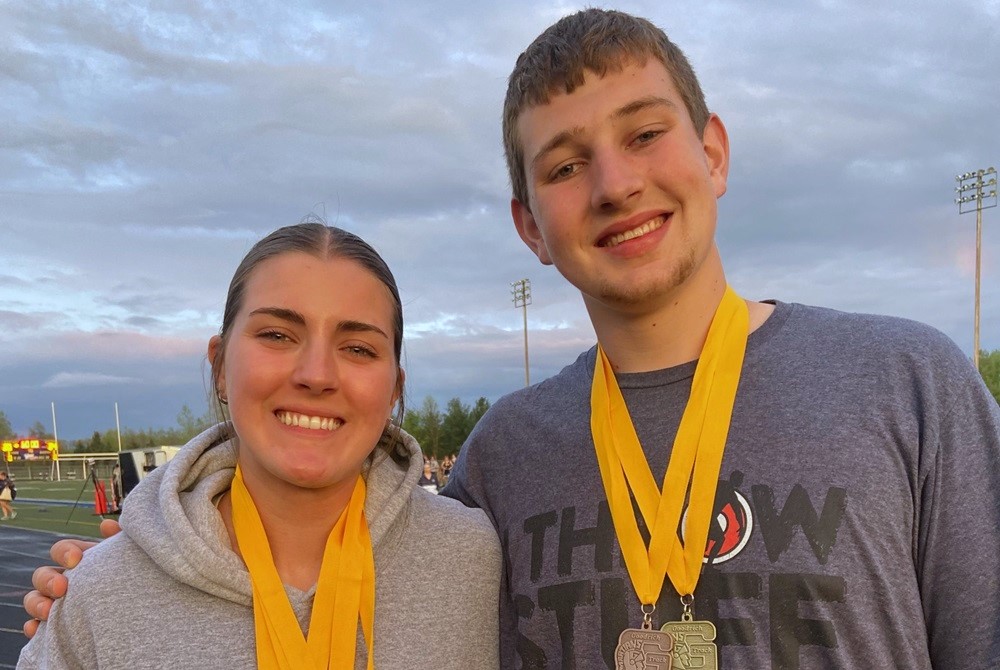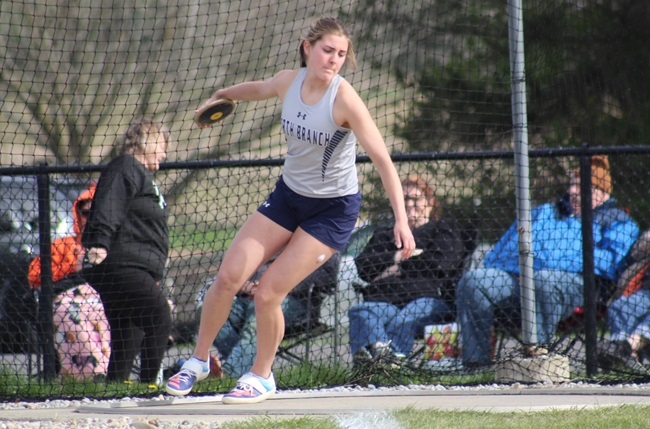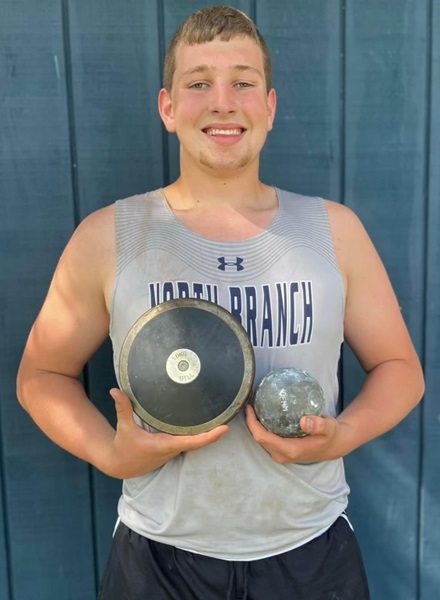
Hastings Relays Reigns as State's Oldest Continuous Track & Field Meet
By
Steve Vedder
Special for MHSAA.com
April 10, 2024
Bob Branch remembers dabbling in other sports, but his first love was always running.
 The Hastings High School graduate admits he could never hit a baseball, football didn't especially appeal to him and basketball was just another way to spend time with friends. But for Branch, now 93, there was always track. That's the sport where his fondest and sharpest memories remain. And if you're talking track, many of his favorite memories come from participation in the state's oldest continuous track meet, the Hastings Relays.
The Hastings High School graduate admits he could never hit a baseball, football didn't especially appeal to him and basketball was just another way to spend time with friends. But for Branch, now 93, there was always track. That's the sport where his fondest and sharpest memories remain. And if you're talking track, many of his favorite memories come from participation in the state's oldest continuous track meet, the Hastings Relays.
Always held in early April, the meet dates back to 1937 – a bygone time that saw the first hostilities of World War II, gas at 20 cents a gallon and a loaf of bread selling for a dime.
And at a dusty old track surrounding the county fairgrounds in Hastings, a small relay event that included a scattering of participants from a dozen high schools was taking its first tentative steps.
Branch recalls a time when kids would run home after track practice because there were no buses, inexperienced young coaches had little actual knowledge of running fundamentals, and athletes looked at the sport as an afterthought after spending most of their high school days playing football and basketball.
 For Branch, the relays were the ideal way to ease into the track season.
For Branch, the relays were the ideal way to ease into the track season.
"I just liked to run," said Branch. "I remember I anchored a relay with my brother, and it always seemed cold when we had that meet. I remember teams would come from all over and you saw a lot of good athletes. Everybody seemed to have someone who was really good. Track wasn't very popular at that time, but I have a lot of good memories from running."
The Hastings Relays, which has changed formats and even names during its nearly nine-decade history, would traditionally kick off the track season. The meet was originally held at a makeshift quarter-mile track which surrounded the town's fairgrounds and was part of the city's annual Hastings Carnival – the track would become the midway during fair time.
The meet eventually moved to Johnson Field when the football field was dedicated in 1949 and ballooned to as many as 50 teams at its peak in 1957. For more than seven decades it was known as the Hastings Relays and then the Hastings Co-Ed relays before becoming the current Hastings Invitational, with the latest edition scheduled for Friday.
Johnson Field had a cinder track before it became an all-weather surface in the 1980s. During a time long before computers would be used to organize meet heats in mere minutes, Hastings coaches of all sports – defined as "volunteers" by the athletic department – would meet on the Friday before competition to hash out events.
People associated with the meet still recall the camaraderie built on those long Friday nights, followed by working what would often become 10-hour meets. Steve Hoke has been involved since watching his father, Jack, who coached teams at 15 of the meets beginning in 1951 and also had run in the first Hastings Relays. Steve Hoke later competed in the Relays as well during the early 1970s before becoming an assistant track coach, later the Hastings athletic director and now a volunteer worker.
"It was always a huge deal," said Hoke, who said the meet began as a pure relay event before transitioning to its current team format in the 1990s. "I remember we'd line the track the night before, and all the coaches would come to the house to organize everything. There was a brotherhood.”
 If you quiz many of the fleet of volunteers who've worked the relays over the years, each has a different memory from the meet. While Hoke describes the brotherhood and Branch the outstanding competition, others remember weather and the time a thunderstorm wiped out the line markings on the cinder track, or waking up to find three inches of snow that caused a rare cancellation of the meet. Others recall the shock of moving from the cinder to all-weather track or using the meet as an early measuring stick of what it would take to qualify for the state meet. The real old-timers remember the meet disappearing for three years during World War II.
If you quiz many of the fleet of volunteers who've worked the relays over the years, each has a different memory from the meet. While Hoke describes the brotherhood and Branch the outstanding competition, others remember weather and the time a thunderstorm wiped out the line markings on the cinder track, or waking up to find three inches of snow that caused a rare cancellation of the meet. Others recall the shock of moving from the cinder to all-weather track or using the meet as an early measuring stick of what it would take to qualify for the state meet. The real old-timers remember the meet disappearing for three years during World War II.
Hastings native and Western Michigan grad Tom Duits was the state’s second collegian to break the four-minute mile when he ran a 3:59.2 at a meet in Philadelphia in 1978. Duits, who ran in three Hastings Relays, was in line to join the U.S. Olympic team in 1980 before the United States pulled out of the games due to tension with Russia.
Duits has his own memories of the meet and the competition he faced there.
"I remember sunshine and being excited to be competing again. There were all these athletes swarming around; it was an awesome display of talent," he said. "It was always one of the best meets we'd be in. You could pretty much see the level of runners who would be at state, which made it a big deal. It was always early, but you could tell where you stood. It was great exposure."
Hastings track star Wayne Oom competed in four Hastings Relays from 1984-87. One of his sharpest memories was the difference between running on a raw cinder track versus the far more comfortable all-weather surface.
"Those cinders would grind into your skin," said Oom, part of the Hastings school record in the two-mile relay. "But I think it helped us because when we'd go to other tracks, it seemed we would run faster. I remember how competitive it was, especially in the distances. There were some great runners."
While participants have their unique memories, so do coaches. Former Saxons coach Paul Fulmer remembers 2008 when his team finished first on the boys side of the meet while his wife, Grand Haven coach Katie Kowalczyk-Fulmer, saw her girls team win the championship.
 "I knew we were one of the favorites to win because we were usually near the top of our conference and Regional," he said. "But then Katie's team was pretty good, and it was cool for them to win too."
"I knew we were one of the favorites to win because we were usually near the top of our conference and Regional," he said. "But then Katie's team was pretty good, and it was cool for them to win too."
Fulmer, who coached Hastings from 1978-81 and then 1985-2010, said at least part of the meet's popularity was derived from a unique way of scoring. Instead of individuals earning points solo, participants worked in pairs. For instance, two athletes would combine their shot put or long jump scores. New events such as the 1,500 relay and sprint medley were added.
"We had a tradition of being the state's oldest meet, and that was a big deal," Fulmer said. "And we ran a good relay; that attracted teams too. We took a lot of pride in that.
"And we'd get quite a lot of people to come to the meet. We'd set up until like 9 or 10 p.m., and then we'd have a party with all the coaches on Friday night."
While the meet has stretched 87 years, Branch said early participants and current runners have one thing in common: a drive to win. Branch ran in an era when the popularity of high school track was in its infancy. Today some of the best all-around athletes at a school are involved in the track program. The relays span the nearly nine decades in between.
"The quality of teams has gotten better and better," said Branch, the 1947 Lower Peninsula Class B Finals champ in the 220. "And this has made for a better meet. We would get guys who played football or baseball kind of drift into track, and that made the sport better. I think people began to appreciate track because we'd get teams from all over.
"We went from not really knowing what we were doing to track being a good sport. Even then, I'm not sure we appreciated what we had. We really liked the Hastings Relays and always wanted to do well there. It became popular and quite an honor to do well. Those are the kind of things I remember."
PHOTOS (Top) Racers run at the Hastings Relays, with several more awaiting their turns to compete at the longtime meet. (2) The author wrote on the 50th anniversary of the Relays for the Hastings Banner nearly 40 years ago. (3) Past athlete, coach and athletic director Steve Hoke shows some of the Relays awards from the 1930s. (4) Tom Duits was one of the state’s biggest track stars of the 1970s and ran in three Hastings Relays. (Top photo by Dan Goggins, Hoke photo provided by Steve Hoke and Duits photos provided by Tom Duits.)

North Branch Cousins Carry on Family Tradition with Record-Setting Throws
By
Paul Costanzo
Special for MHSAA.com
April 16, 2025
Aubree Deshetsky wasn’t able to be there last week when her cousin, Eli Bickel, broke the 30-year-old North Branch discus record.
 She was there, however, when the former record holder, her dad Daniel Deshetsky, got the call.
She was there, however, when the former record holder, her dad Daniel Deshetsky, got the call.
“I was with my dad at a volleyball tournament in Louisville,” Aubree Deshetsky said. “We wanted (Eli) to break the record. It was cool to see him do that.”
Bickel not only knocked his uncle off the Broncos’ record board with his throw of 160 feet, 4 inches on April 11 at Davison, he joined Aubree as the school’s all-time leaders in the event. She had thrown 131-5 two days earlier, breaking her own school record.
The similarities go well beyond that. Both have committed to Division I universities in other sports. Deshetsky will be playing volleyball at Wofford (South Carolina), while Bickel has committed to play football at Michigan State.
And they’re both still juniors.
“I think for both of them, they’re not done,” North Branch athletic director and throwing coach Al Margrif said. “They’re both really motivated to be able to make their best marks this year. Eli, he puts in a lot of study. He watches a lot of film. He has a cousin that he talks to that’s a (collegiate) throws coach. He’s more technical and a student of discus. Aubree, she’s a super-fast learner. She’s just so athletic, and it just comes out so much.”
 Deshetsky is a two-time Finals champion in volleyball, winning titles her freshman and sophomore seasons. She’s also a returning all-state thrower, having taken fifth in the shot put and sixth in the discus at the Lower Peninsula Division 2 Finals a year ago.
Deshetsky is a two-time Finals champion in volleyball, winning titles her freshman and sophomore seasons. She’s also a returning all-state thrower, having taken fifth in the shot put and sixth in the discus at the Lower Peninsula Division 2 Finals a year ago.
That’s despite never really being solely focused on throwing. During her freshman year, she ran the 200, 400 and 800 meters, multiple relays and also high jumped along with her throwing events.
As a sophomore, she cut back on some of those races and the high jump, but was part of North Branch’s 400-meter relay team, which qualified for the Division 2 Finals.
And all along, she’s been playing high-level club volleyball, which takes her around the country.
“I kind of (started throwing) because my dad threw in high school,” she said. “It’s just something my family has done. I was really a big high jumper and 800 runner in middle school and early high school, but once volleyball ramped up more, it was harder to train for those, so I focused more on the throwing side. I got serious into discus last year. But my coach, he literally puts us in events at the meets to get us the most points, so I just do whatever he asks and hope for the best.”
She threw 127-1 at the Blue Water Area Conference championship meet a year ago to claim the school record. That came last May, so to be well ahead of that right now in early April is a good sign for what she wants to accomplish this season.
“I was actually very surprised,” she said. “That meet was my first time throwing outdoors this year. We’ve just been practicing inside, but something that’s helped this year, our school has these foam rings and with rubber discs, I can basically do a full throw into a divider in the gym. But I honestly did not expect to throw that far. I’m kind of aiming for the 140 mark this year. I think starting out at 131 is a good starting point.”
Bickel, who will play on the offensive line at MSU, has been more focused on throwing since middle school. He started tagging along to throwing practices when his sister Natasha, a 2023 North Branch graduate who was Deshetsky’s volleyball teammate, began competing in high school, and realized pretty quickly he had a future in the sport. So much so that he originally thought throwing could be his path to becoming a college athlete.
 All along, he had his uncle’s record in his sights.
All along, he had his uncle’s record in his sights.
“It’s been a goal of mine,” Bickel said. “I knew I could do it. Last year was a frustrating year, because I hit that mark so many times in practice, but I never could in a meet. This was my first meet this year – I got cleared on Tuesday (after recovering from a torn meniscus), then the next day I threw 151 and felt good. Then Friday came and my first two throws, I was over-excited, but my next throw, I really connected.”
Bickel is a four-sport athlete at North Branch, as he wrestled and played basketball this winter. Even though he did get injured in January, he said the MSU staff has been supportive of him continuing to branch out.
“They actually encouraged it,” Bickel said. “They wanted people who could stay moving and be athletic on the offensive line.”
His football commitment could mean this is his final track season, however, as there’s a chance he will enroll early at MSU. That put some more urgency into breaking that record this season and getting back to the Division 2 Finals to make up for a disappointing finish a year ago.
He’s certainly on track to do that, as his record-breaking throw is currently the best in Division 2 this spring.
The best throw for Division 2 girls, meanwhile, belongs to Deshetsky.
It’s fitting for cousins who have had simultaneous success for so long.
“Our family is very close together,” Bickel said. “We actually do 4-H in the summer, and they show pigs out of our barn. I go to every one of her volleyball games that I can make it to. On the track side of things, there are times on a Saturday afternoon where I’ll ask her if she wants to go practice throwing, and she’ll do it.”
 Paul Costanzo served as a sportswriter at The Port Huron Times Herald from 2006-15, including three years as lead sportswriter, and prior to that as sports editor at the Hillsdale Daily News from 2005-06. He can be reached at paulcostanzo3@gmail.com with story ideas for Genesee, Lapeer, St. Clair, Sanilac, Huron, Tuscola, Saginaw, Bay, Arenac, Midland and Gladwin counties.
Paul Costanzo served as a sportswriter at The Port Huron Times Herald from 2006-15, including three years as lead sportswriter, and prior to that as sports editor at the Hillsdale Daily News from 2005-06. He can be reached at paulcostanzo3@gmail.com with story ideas for Genesee, Lapeer, St. Clair, Sanilac, Huron, Tuscola, Saginaw, Bay, Arenac, Midland and Gladwin counties.
PHOTOS (Top) Cousins Aubree Deshetsky, left, and Eli Bickel take a photo together during a successful day last season at the Goodrich Invitational. (Middle) Deshetsky unwinds during a discus throw. (Below) Bickel holds up his discus and shot put. (Photos courtesy of the North Branch athletic department.)

